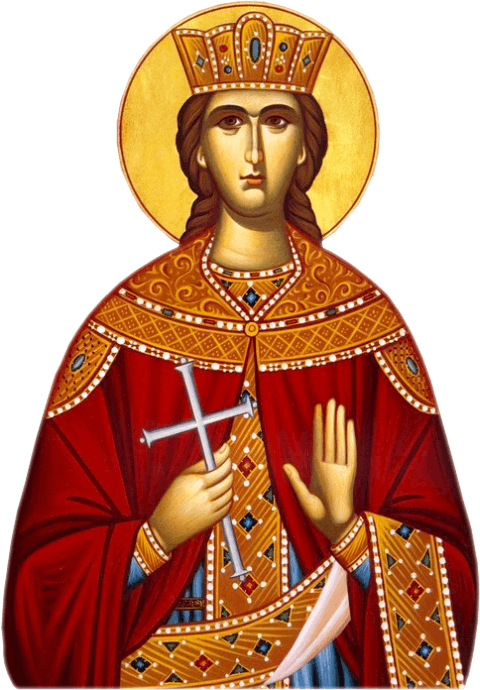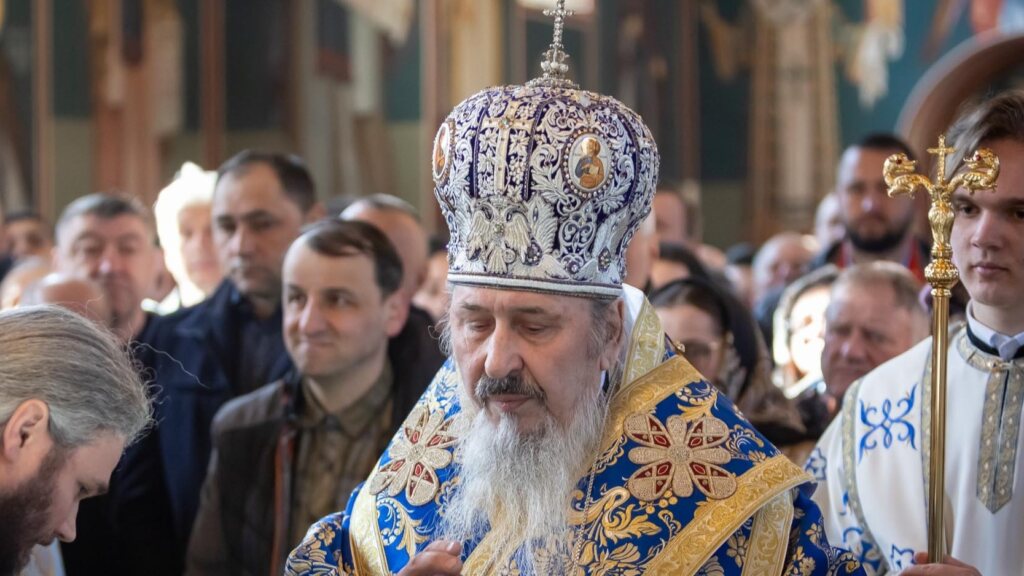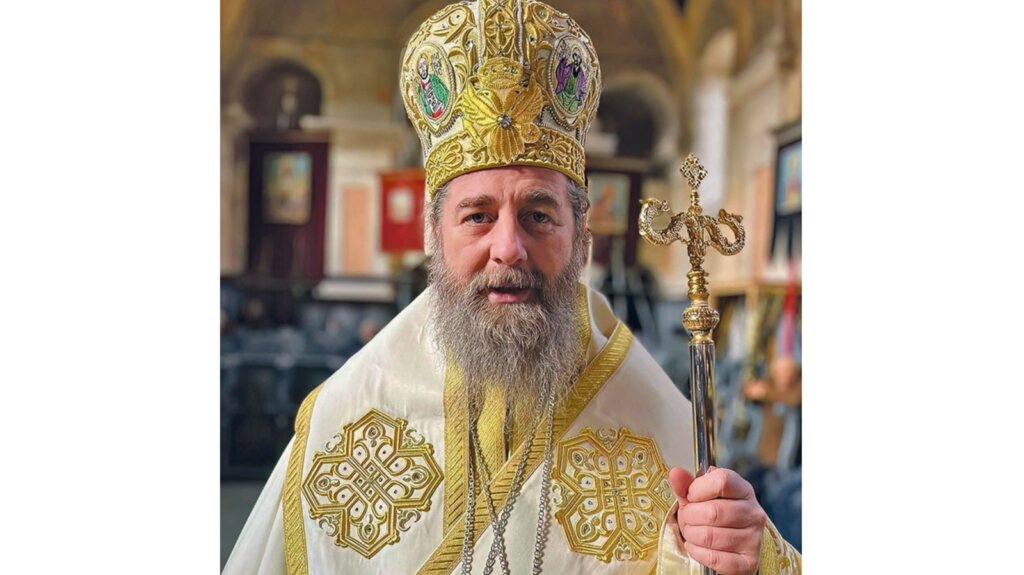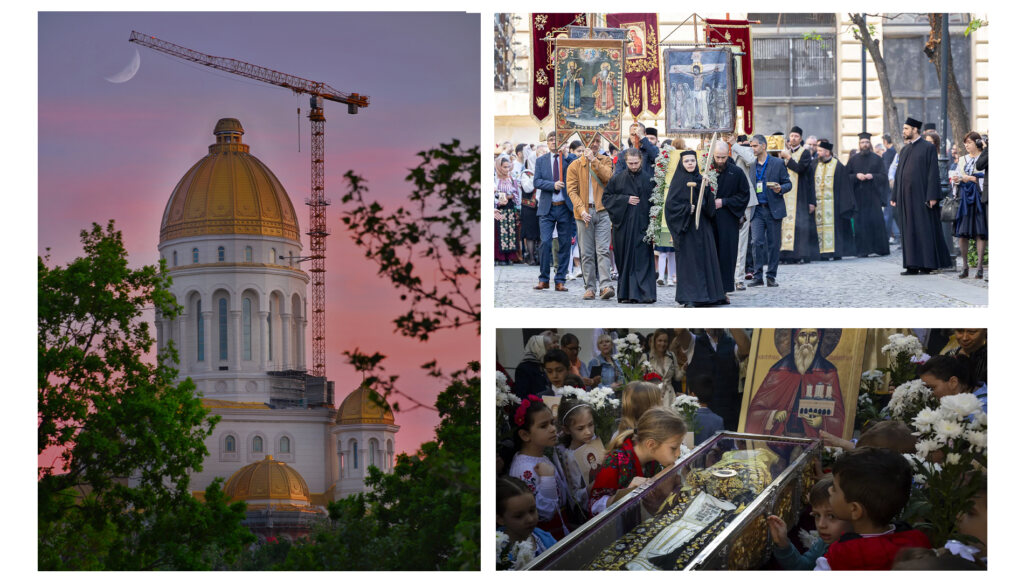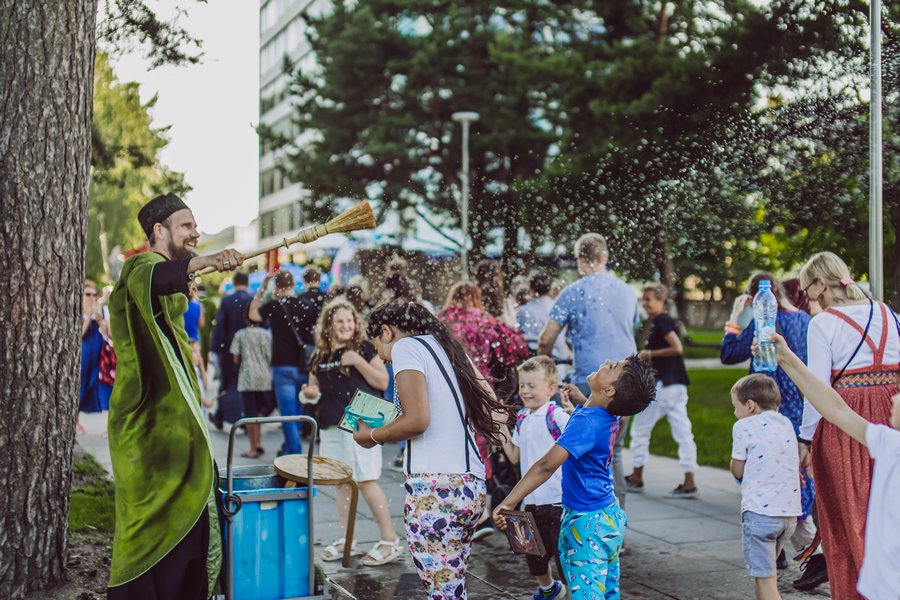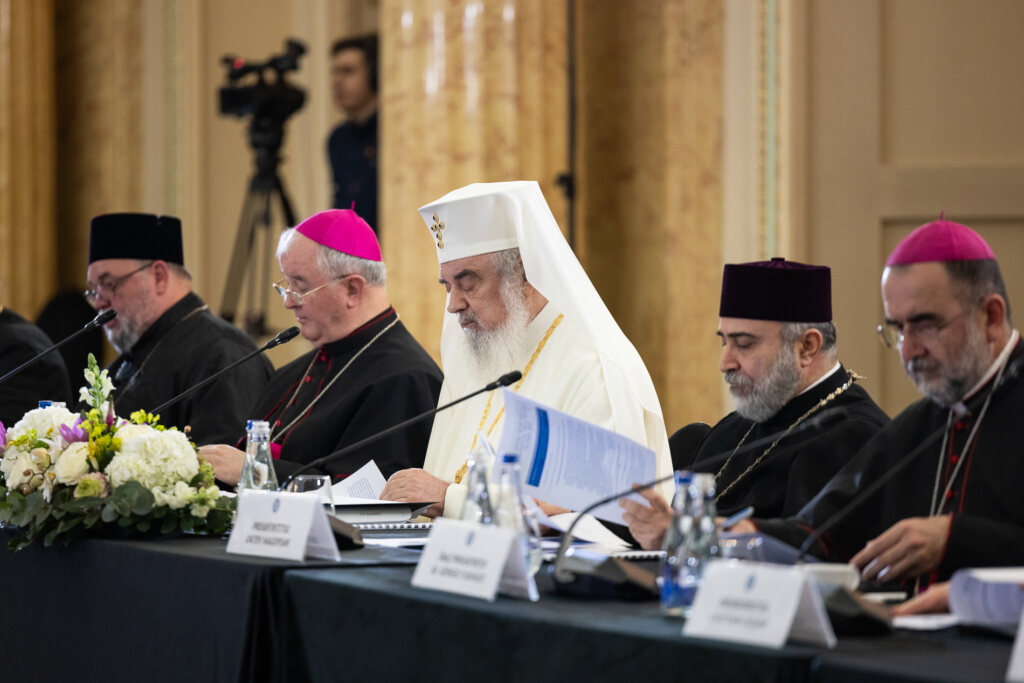The holy Great Martyr Irene was born in the city of Magedon in Persia during the fourth century. She was the daughter of the pagan king Licinius, and her parents named her Penelope.
Penelope was very beautiful, and her father kept her isolated in a high tower from the time she was six so that she would not be exposed to Christianity. He also placed thirteen young maidens in the tower with her.
An old tutor by the name of Apellian was assigned to give her the best possible education. Apellian was a Christian, and during her lessons, he told the girl about Christ the Savior and taught her the Christian Faith and the Christian virtues.
When Penelope reached adolescence, her parents began to think about her marriage. One day, a dove flew through the window carrying an olive branch in its beak, depositing it upon a table. Then an eagle swooped in with a wreath of flowers in its beak, and also placed it upon the table. Finally, a raven flew in carrying a snake, which it dropped on the table. Penelope was puzzled by these events and wondered what they meant.
Apellian explained that the dove signified her education, and the olive branch stood for the grace of God which is received in Baptism. The eagle with the wreath of flowers represented success in her future life. The raven and the snake foretold her future suffering and sorrow.
At the end of the conversation Apellianus said that the Lord wished to betroth her to Himself and that Penelope would undergo much suffering for her heavenly Bridegroom. After this Penelope refused marriage, was baptized by the priest Timothy, and she was named Irene (peace). She even urged her own parents to become Christians. Shortly after this, she destroyed all her father’s idols.
Since Saint Irene had dedicated herself to Christ, she refused to marry any of the suitors her father had chosen for her. When Licinius learned that his daughter refused to worship the pagan gods, he was furious. He attempted to turn her from Christ by having her tortured. She was tied up and thrown beneath the hooves of wild horses so that they might trample her to death, but he horses remained motionless.
Instead of harming the saint, one of the horses charged Licinius, seized his right hand and tore it from his arm. Then it knocked Licinius down and began to trample him. They untied the holy virgin, and through her prayers Licinius rose unharmed in the presence of eyewitnesses with his hand intact.
Seeing such a miracle, Licinius and his wife, and many of the people, (about 3000 men) believed in Christ and turned from the pagan gods. Resigning his administrative duties, Licinius devoted himself to the service of the Lord Jesus Christ. Saint Irene lived in the house of her teacher Apellian, and she began to preach Christ among the pagans, converting them to the path of salvation.
When Sedecius, the new prefect of the city, heard of this miracle he summoned Apellian and questioned him about Irene’s manner of life. Apellian replied that Irene, like other Christians, lived in strict temperance, devoting herself to constant prayer and reading holy books. Sedecius summoned the saint to him and urged her to stop preaching about Christ. He also attempted to force her to sacrifice to the idols.
Saint Irene staunchly confessed her faith before the prefect, not fearing his wrath, and prepared to undergo suffering for Christ. By order of Sedecius she was thrown into a pit filled with vipers and serpents. The saint spent ten days in the pit and remained unharmed, for an angel of the Lord protected her and brought her food.
Sedecius ascribed this miracle to sorcery, and he subjected Saint Irene to many other tortures, but she remained unharmed. Under the influence of her preaching and miracles even more people were converted to Christ, and turned away from the worship of inanimate idols.
Sedecius was deposed by his son Savorus, who persecuted Christians with an even greater zeal than his father had done. Saint Irene went to her home town of Magedon in Persia to meet Savorus and his army, and ask him to end the persecution. When he refused, Saint Irene prayed and his entire army was blinded. She prayed again and they received their sight once more. In spite of this, Savorus refused to recognize the power of God. Because of his insolence, he was struck and killed by a bolt of lightning.
After this, Saint Irene walked into the city and performed many miracles. She returned to the tower built by her father, accompanied by the priest Timothy. Through her teaching, she converted five thousand people to Christ.
Next, the saint went to the city of Callinicus, or Callinicum (possibly on the Euphrates River in Syria). The ruler of that place was King Numerian, the son of Sebastian. When she began to teach about Christ, she was arrested and tortured by the pagan authorities. She was placed into three bronze oxen which were heated by fire. She was transferred from one to another, but miraculously she remained uninjured. Thousands of idolaters embraced Christianity as a result of this wondrous event.
Sensing the approach of death, Numerian instructed his eparch Babdonus to continue torturing the saint in order to force her to sacrifice to idols. Once again, the tortures were ineffective, and many people turned to Christ.
Christ’s holy martyr then traveled to the city of Constantina, forty miles northeast of Edessa. By 330, the Persian king Sapor II (309-379) had heard of Saint Irene’s great miracles. To prevent her from winning more people to Christ, she was arrested, beheaded, and then buried. However, God sent an angel to raise her up again, and she went into the city of Mesembria. After seeing her alive and hearing her preach, the local king was baptized with many of his subjects.
Wishing to convert even more pagans to Christianity, Saint Irene went to Ephesus, where she taught the people and performed many miracles. The Lord revealed to her that the end of her life was approaching. Then Saint Irene left the city accompanied by six people, including her former teacher Apellian. On the outskirts of the town, she found a new tomb in which no one had ever been buried. After making the Sign of the Cross, she went inside, directing her companions to close the entrance to the cave with a large stone, which they did. When Christians visited the cave four days later, they did not find the body of the saint.
Apellian returned after only two days, and found the stone rolled away and the tomb empty. Thus did God glorify Saint Irene, who loved Him and devoted her life to serving Him. Although many of these miracles may seem improbable to those who are skeptical, nothing is impossible with God.
Saint Irene led thousands of people to Christ through her preaching, and by her example. The Church continues to honor her memory and to seek her heavenly intercession.
The holy, glorious Great Martyr Irene is invoked by those wishing to effect a swift and happy marriage. In Greece, she is also the patron saint of policemen. Saint Irene is also one of the twelve Virgin Martyrs who appeared to Saint Seraphim of Sarov (January 2) and the Diveyevo nun Eupraxia on the Feast of the Annunciation in 1831. By her holy prayers, may the Lord have mercy upon us and save us.
Troparion, tone 1:
Christ called you Irene; for you grant peace to those who celebrate your memory, hastening to your holy temple with hymns and spiritual songs, for you intercede for all before the Three-Sunned Divinity, Let everyone celebrate her memory joyously, glorifying Christ, Who glorified her.
The holy New Martyr and wonderworker Ephraim was born in Greece on September 14, 1384. His father died when the saint was young, and his pious mother was left to care for seven children by herself.
When Ephraim reached the age of fourteen, the all-good God directed his steps to a monastery on the mountain of Amoman near Nea Makri in Attica. The monastery was dedicated to the Annunciation and also to Saint Paraskeva. Here he took on his shoulders the Cross of Christ, which all His followers must bear (Matt. 16:24).
Being enflamed with love for God, Saint Ephraim eagerly placed himself under the monastic discipline. For nearly twenty-seven years he imitated the life of the great Fathers and ascetics of the desert. With divine zeal, he followed Christ and turned away from the attractions of this world. By the grace of God, he purified himself from soul-destroying passions and became an abode of the All-Holy Spirit. He was also found worthy to receive the grace of the priesthood, and served at the altar with great reverence and compunction.
On September 14, 1425, the barbarous Turks launched an invasion by sea, destroying the monastery and and looting the surrounding area. Saint Ephraim was one of the victims of their frenzied hatred. Many of the monks had been tortured and beheaded, but Saint Ephraim remained calm. This infuriated the Turks, so they imprisoned him in order to torture him and force him to deny Christ.
They locked him in a small cell without food or water, and they beat him every day, hoping to convince him to become a Moslem. For several months, he endured horrible torments. When the Turks realized that the saint remained faithful to Christ, they decided to put him to death. On Tuesday May 5, 1426, they led him from his cell.
They turned him upside down and tied him to a mulberry tree, then they beat him and mocked him. “Where is your God,” they asked, “and why doesn’t he help you?” The saint did not lose courage, but prayed, “O God, do not listen to the words of these men, but may Thy will be done as Thou hast ordained.”
The barbarians pulled the saint’s beard and tortured him until his strength ebbed. His blood flowed, and his clothes were in tatters. His body was almost naked and covered with many wounds. Still the Hagarenes were not satisfied, but wished to torture him even more. One of them took a flaming stick and plunged it violently into the saint’s navel. His screams were heart-rending, so great was his pain.
The blood flowed from his stomach, but the Turks did not stop. They repeated the same painful torments many times. His body writhed, and all his limbs were convulsed. Soon, the saint grew too weak to speak, so he prayed silently asking God to forgive his sins. Blood and saliva ran from his mouth, and the ground was soaked with his blood. Then he lapsed into unconsciousness.
Thinking that he had died, the Turks cut the ropes which bound him to the tree, and the saint’s body fell to the ground. Their rage was still not diminished, so they continued to kick and beat him. After a while, the saint opened his eyes and prayed, “Lord, I give up my spirit to Thee.” About nine o’clock in the morning, the martyr’s soul was separated from his body.
These things remained forgotten for nearly 500 years, hidden in the depths of silence and oblivion until January 3, 1950. By then a women’s monastery had sprung up on the site of the old monastery. Abbess Makaria (+ April 23, 1999) was wandering through the ruins of the monastery, thinking of the martyrs whose bones had been scattered over that ground, and whose blood had watered the tree of Orthodoxy. She realized that this was a holy place, and she prayed that God would permit her to behold one of the Fathers who had lived there.
After some time, she seemed to sense an inner voice telling her to dig in a certain spot. She indicated the place to a workman whom she had hired to make repairs at the old monastery. The man was unwilling to dig there, for he wanted to dig somewhere else. Because the man was so insistent, Mother Makaria let him go where he wished. She prayed that the man would not be able to dig there, and so he struck rock. Although he tried to dig in three or four places, he met with the same results. Finally, he agreed to dig where the abbess had first indicated.
In the ruins of an old cell, he cleared away the rubble and began to dig in an angry manner. The abbess told him to slow down, for she did not want him to damage the body that she expected to find there. He mocked her because she expected to find the relics of a saint. When he reached the depth of six feet, however, he unearthed the head of the man of God. At that moment an ineffable fragrance filled the air.
The workman turned pale and was unable to speak. Mother Makaria told him to go and leave her there by herself. She knelt and reverently kissed the body. As she cleared away more earth, she saw the sleeves of the saint’s rasson. The cloth was thick and appeared to have been woven on the loom of an earlier time. She uncovered the rest of the body and began to remove the bones, which appeared to be those of a martyr.
Mother Makaria was still in that holy place when evening fell, so she read the service of Vespers. Suddenly she heard footsteps coming from the grave, moving across the courtyard toward the door of the church. The footsteps were strong and steady, like those of a man of strong character. The nun was afraid to turn around and look, but then she heard a voice say, “How long are you going to leave me here?”
She saw a tall monk with small, round eyes, whose beard reached his chest. In his left hand was a bright light, and he gave a blessing with his right hand. Mother Makaria was filled with joy and her fear disappeared. “Forgive me,” she said, “I will take care of you tomorrow as soon as God makes the day dawn.” The saint disappeared, and the abbess continued to read Vespers.
In the morning after Matins, Mother Makaria cleaned the bones and placed them in a niche in the altar area of the church, lighting a candle before them. That night Saint Ephraim appeared to her in a dream. He thanked her for caring for his relics, then he said, “My name is Saint Ephraim.” From his own lips, she heard the story of his life and martyrdom.
Since Saint Ephraim glorified God in his life and by his death, the Lord granted him the grace of working miracles. Those who venerate his holy relics with faith and love have been healed of all kinds of illnesses and infirmities, and he is quick to answer the prayers of those who call upon him.
Troparion, tone 1:
Thou didst shine forth like the sun on the mountain of Ammomon, O God-bearer, and through martyrdom thou didst depart unto God. Thou didst endure the invasion of the barbarians, O Ephraim, Great Martyr of Christ. Therefore, thou dost gush forth grace forever to those who devoutly call upon thee. Glory to Him Who gave thee strength! Glory to Him Who magnified thee! Glory to Him Who, through thee, granteth healing to all!

